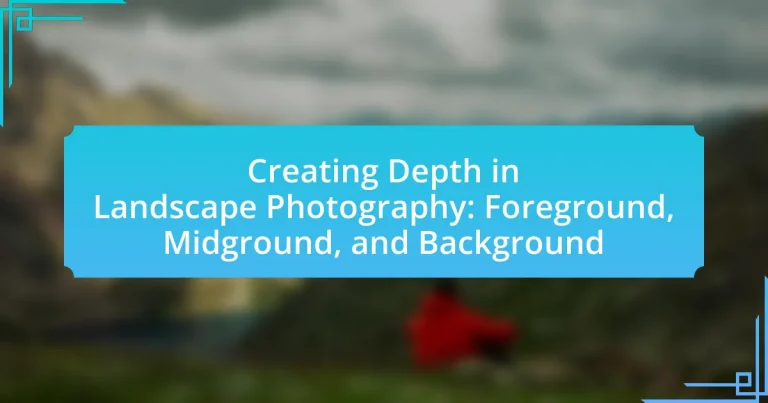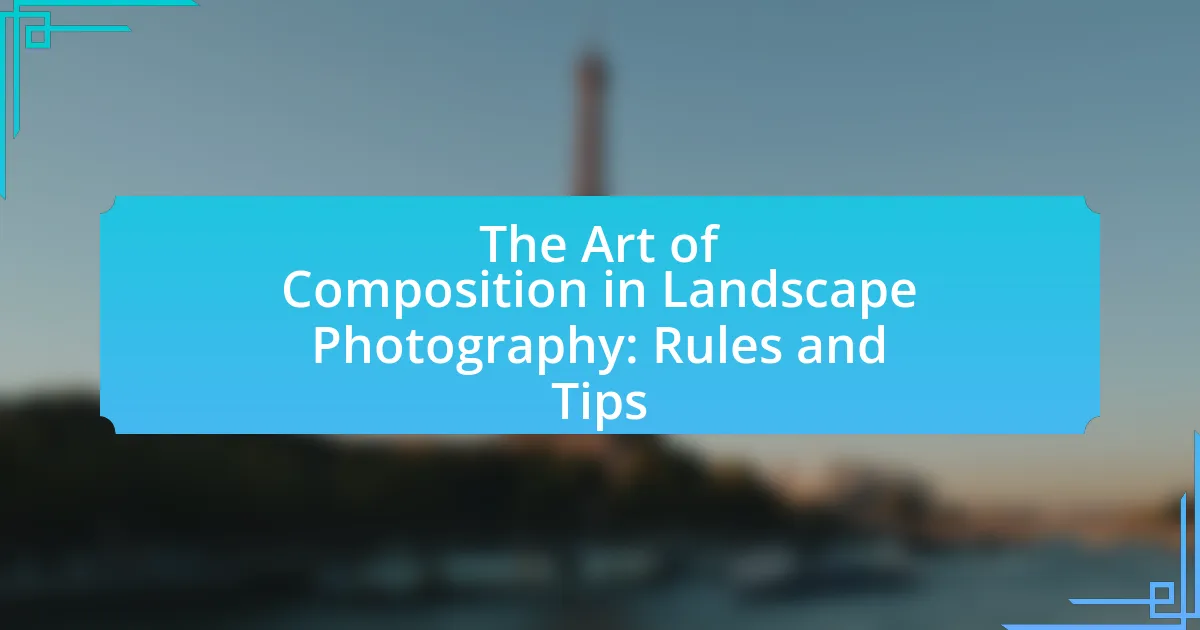The article focuses on the concept of depth in landscape photography, emphasizing the importance of foreground, midground, and background elements in creating a three-dimensional perception within a two-dimensional image. It outlines how these components enhance viewer engagement by establishing scale and guiding the eye through the composition. Key techniques for achieving depth, such as using leading lines, atmospheric perspective, and appropriate aperture settings, are discussed, along with the impact of lighting and atmospheric conditions on the overall mood and effectiveness of landscape photographs. The article provides practical tips for photographers to effectively incorporate depth into their work, ensuring a more immersive visual experience.

What is Depth in Landscape Photography?
Depth in landscape photography refers to the perception of three-dimensional space within a two-dimensional image, achieved by effectively utilizing foreground, midground, and background elements. This technique enhances the viewer’s experience by creating a sense of scale and distance, making the scene more immersive. For instance, incorporating objects in the foreground, such as rocks or plants, alongside distant mountains or skies in the background, can significantly contribute to the overall depth of the photograph. Studies in visual perception indicate that images with clear depth cues are more engaging and can evoke stronger emotional responses from viewers.
Why is depth important in landscape photography?
Depth is important in landscape photography because it enhances the three-dimensionality of an image, making it more engaging and visually appealing. By incorporating elements in the foreground, midground, and background, photographers create layers that guide the viewer’s eye through the scene. This technique not only adds interest but also helps convey the scale and vastness of the landscape, allowing viewers to feel a sense of immersion. Studies in visual perception indicate that images with depth are more likely to capture attention and evoke emotional responses, reinforcing the significance of depth in effective landscape photography.
How does depth influence the viewer’s perception?
Depth significantly influences the viewer’s perception by creating a sense of three-dimensionality in a two-dimensional image. This perception is enhanced through the use of foreground, midground, and background elements, which guide the viewer’s eye and establish spatial relationships within the composition. For instance, incorporating a prominent foreground object can draw attention and provide context, while a well-defined background can create a sense of distance and scale. Research in visual perception indicates that depth cues, such as overlapping objects and atmospheric perspective, are critical in helping viewers interpret spatial arrangements, thereby enhancing their overall experience of the image.
What role does depth play in storytelling through images?
Depth plays a crucial role in storytelling through images by creating a sense of dimension and perspective that engages viewers. This dimensionality allows the audience to perceive the spatial relationships between elements within the frame, enhancing the narrative conveyed by the image. For instance, in landscape photography, incorporating foreground, midground, and background elements can guide the viewer’s eye and evoke emotions, making the scene more immersive. Research indicates that images with clear depth cues, such as overlapping objects and varying focus, are more effective in capturing attention and conveying complex stories, as they mimic human visual perception.
What are the key components of depth in landscape photography?
The key components of depth in landscape photography are foreground, midground, and background elements. Foreground elements, such as rocks or plants, create a sense of scale and lead the viewer’s eye into the scene. Midground elements, like hills or trees, provide context and connect the foreground to the background. Background elements, such as mountains or the sky, establish the overall setting and contribute to the composition’s depth. This layering of elements enhances the three-dimensional feel of the photograph, making it more engaging and visually appealing.
How do foreground, midground, and background contribute to depth?
Foreground, midground, and background contribute to depth in landscape photography by creating layers that enhance the perception of three-dimensional space. The foreground typically includes elements that are closest to the camera, providing a sense of scale and context; for example, rocks or flowers can draw the viewer’s eye and establish a point of reference. The midground serves as a transition area, often containing subjects like trees or hills that connect the foreground to the background, thereby guiding the viewer’s gaze through the composition. The background usually features distant elements such as mountains or skies, which help to establish the overall setting and provide a sense of distance. Together, these three layers create a visual hierarchy that enhances depth perception, making the scene more immersive and engaging for the viewer.
What techniques can enhance the sense of depth in a photograph?
Techniques that can enhance the sense of depth in a photograph include the use of foreground elements, leading lines, and atmospheric perspective. Foreground elements, such as rocks or plants, create a three-dimensional feel by providing a reference point for the viewer. Leading lines, like roads or rivers, guide the viewer’s eye through the image, emphasizing the distance between the foreground and background. Atmospheric perspective involves using color and clarity to depict depth; distant objects appear lighter and less detailed due to the effects of the atmosphere. These techniques are widely recognized in photography as effective methods for creating a more immersive visual experience.

How to Utilize Foreground in Landscape Photography?
To utilize foreground in landscape photography, position interesting elements in the foreground to create depth and lead the viewer’s eye into the scene. This technique enhances the three-dimensional feel of the photograph, making it more engaging. For instance, incorporating rocks, flowers, or water in the foreground can provide context and scale, drawing attention to the midground and background elements. Studies in visual perception indicate that foreground elements can significantly enhance the viewer’s experience by establishing a sense of place and perspective, as supported by research from the Journal of Visual Communication in 2019, which highlights the importance of compositional elements in landscape imagery.
What elements should be included in the foreground?
The elements that should be included in the foreground of landscape photography are objects that create interest and depth, such as rocks, flowers, or leading lines like paths or rivers. These elements draw the viewer’s eye into the scene and provide a sense of scale and context. For instance, including a large rock in the foreground can enhance the perception of distance and make the landscape feel more three-dimensional. Additionally, foreground elements can help frame the main subject of the photograph, guiding the viewer’s attention and enhancing the overall composition.
How can leading lines in the foreground guide the viewer’s eye?
Leading lines in the foreground effectively guide the viewer’s eye by creating a visual pathway that draws attention to the main subject of the image. These lines can be natural elements like rivers, roads, or fences that lead from the foreground into the background, establishing a sense of depth and perspective. Research in visual perception indicates that humans are naturally inclined to follow lines and shapes, which enhances the overall composition and engagement with the photograph. For instance, a study published in the journal “Cognitive Science” highlights that viewers are more likely to focus on areas of an image that contain leading lines, reinforcing the importance of this technique in landscape photography.
What are some common mistakes to avoid when composing the foreground?
Common mistakes to avoid when composing the foreground include neglecting to include interesting elements, failing to create a sense of scale, and not considering the foreground’s relationship with the background. Including unengaging or cluttered elements can detract from the overall composition, while a lack of scale can make the scene feel flat. Additionally, ignoring how the foreground interacts with the midground and background can lead to a disjointed image. These mistakes can diminish the depth and visual interest of landscape photographs, ultimately impacting the viewer’s experience.
How does the foreground affect the overall composition?
The foreground significantly influences the overall composition by establishing depth and context within a landscape photograph. It serves as the initial point of interest, drawing the viewer’s eye into the scene and creating a sense of three-dimensionality. For instance, incorporating elements like rocks, flowers, or leading lines in the foreground can enhance the visual narrative and guide the viewer’s gaze toward the midground and background. This technique is supported by the principle of layering, which suggests that a well-defined foreground can enhance the perception of distance and scale, making the composition more engaging and dynamic.
What techniques can create a strong foreground presence?
Techniques that can create a strong foreground presence include the use of leading lines, contrasting colors, and interesting textures. Leading lines, such as paths or rivers, draw the viewer’s eye into the composition, enhancing depth. Contrasting colors between the foreground and background can make the foreground elements stand out more prominently. Additionally, incorporating textures, such as rocks or foliage, adds visual interest and tactile quality, making the foreground more engaging. These techniques are supported by principles of visual perception, which indicate that elements with distinct characteristics are more likely to capture attention and create a sense of depth in landscape photography.
How does lighting impact the foreground in landscape photography?
Lighting significantly impacts the foreground in landscape photography by influencing the visibility, texture, and color of foreground elements. When light is directed at the foreground, it enhances details and creates depth, making the scene more engaging. For instance, during the golden hour, warm light can accentuate textures in rocks or foliage, while harsh midday light may create unflattering shadows that obscure details. Studies show that the quality of light affects the perception of depth; softer light can create a more three-dimensional feel, while strong contrasts can flatten the image. Thus, understanding how different lighting conditions interact with foreground elements is crucial for effective landscape photography.

What Role Does Midground Play in Landscape Photography?
Midground in landscape photography serves to create a sense of depth and dimension within the composition. By incorporating elements in the midground, photographers can guide the viewer’s eye through the image, enhancing the overall narrative and visual interest. For instance, a midground feature such as a hill or a cluster of trees can act as a transition between the foreground and background, establishing layers that contribute to a three-dimensional feel. This technique is supported by principles of visual perception, where the inclusion of midground elements helps to anchor the composition and provide context, making the scene more relatable and engaging for the viewer.
How can midground elements enhance the composition?
Midground elements enhance composition by providing a sense of depth and context within a landscape photograph. They serve as a transitional space between the foreground and background, helping to create layers that guide the viewer’s eye through the image. For instance, including trees, hills, or structures in the midground can establish a visual narrative, making the scene more engaging and dynamic. This layering effect is supported by the principle of visual hierarchy, which suggests that elements placed at varying distances can create a more compelling and three-dimensional appearance in two-dimensional art forms.
What types of subjects work well in the midground?
Subjects that work well in the midground include trees, hills, and structures such as buildings or bridges. These elements provide a sense of scale and context within the landscape, enhancing the overall depth of the composition. For instance, trees can create a natural transition between the foreground and background, while hills can add layers to the scene. Structures like buildings or bridges can serve as focal points that draw the viewer’s eye, making the midground an essential component in landscape photography for achieving a balanced and engaging image.
How does the midground connect the foreground and background?
The midground connects the foreground and background by serving as a transitional space that enhances depth perception in landscape photography. This area often contains elements that link the detailed foreground, such as rocks or plants, to the more distant background, like mountains or skies. By incorporating various visual elements in the midground, photographers create a sense of layering and perspective, which guides the viewer’s eye through the composition. This technique is supported by principles of visual hierarchy, where the midground acts as a bridge that balances the visual weight of the foreground and background, ultimately enriching the overall image.
What techniques can be used to emphasize the midground?
To emphasize the midground in landscape photography, techniques such as selective focus, leading lines, and compositional framing can be employed. Selective focus draws attention to midground elements by blurring the foreground and background, creating a sense of depth. Leading lines, such as paths or rivers, guide the viewer’s eye toward the midground, enhancing its prominence. Compositional framing, using elements like trees or rocks, can also isolate and highlight midground subjects, making them more visually significant. These techniques are supported by principles of visual perception, which indicate that viewers naturally focus on areas of contrast and interest within a scene.
How can depth of field affect the midground’s impact?
Depth of field significantly influences the midground’s impact by controlling the sharpness and clarity of elements within that space. A shallow depth of field can isolate the midground subject, drawing attention to it while blurring surrounding elements, which enhances its prominence in the composition. Conversely, a deep depth of field keeps the midground in focus along with the foreground and background, creating a sense of continuity and context within the landscape. This technique can either emphasize or diminish the midground’s role, depending on the desired visual narrative. For instance, in landscape photography, using a shallow depth of field on a midground element can evoke intimacy, while a deep depth of field can convey vastness and interconnectedness among the scene’s components.
What are the best practices for framing midground subjects?
The best practices for framing midground subjects include using leading lines, maintaining a balanced composition, and ensuring proper depth of field. Leading lines, such as paths or rivers, guide the viewer’s eye toward the midground, enhancing visual interest. A balanced composition can be achieved by positioning midground subjects in relation to foreground and background elements, creating harmony within the frame. Additionally, using a shallow depth of field can help isolate midground subjects, making them stand out while still providing context from the surrounding landscape. These techniques are supported by principles of visual perception, which suggest that well-framed subjects enhance viewer engagement and understanding of the scene.

How to Incorporate Background in Landscape Photography?
To incorporate background in landscape photography, position elements that create depth and context behind the main subject. This can be achieved by selecting a background that complements the foreground and midground, such as mountains, trees, or clouds, which enhances the overall composition. For instance, using a wide-angle lens can help capture expansive backgrounds, while ensuring that the background is not overly distracting from the main subject. Additionally, utilizing techniques like layering and leading lines can guide the viewer’s eye through the image, emphasizing the relationship between the foreground and background.
What should be considered when selecting background elements?
When selecting background elements in landscape photography, it is essential to consider their visual impact on the overall composition. Background elements should complement the foreground and midground, enhancing the sense of depth and guiding the viewer’s eye through the image. For instance, a well-defined horizon line or interesting textures can add layers to the photograph, making it more engaging. Additionally, the color palette of the background should harmonize with the other elements, as contrasting colors can create tension or draw attention away from the main subject. Research indicates that backgrounds with varying tones and patterns can significantly influence the perception of depth, as demonstrated in studies on visual perception in photography.
How can the background complement the foreground and midground?
The background can complement the foreground and midground by providing context, enhancing depth, and creating visual balance in landscape photography. A well-chosen background can frame the main subjects in the foreground and midground, guiding the viewer’s eye through the composition. For example, mountains or clouds in the background can add layers of interest and scale, making the foreground elements, such as trees or water, appear more prominent. This technique is supported by principles of composition, such as the rule of thirds, which suggests that placing key elements along intersecting lines can create a more dynamic and engaging image.
What techniques can help in achieving a balanced background?
Techniques that can help in achieving a balanced background in landscape photography include using layers, controlling depth of field, and incorporating leading lines. Utilizing layers involves arranging elements in the background to create a sense of depth, which enhances the overall composition. Controlling depth of field allows photographers to isolate the subject while keeping the background visually appealing, ensuring it complements rather than distracts from the main focus. Incorporating leading lines guides the viewer’s eye through the image, creating a harmonious balance between the foreground, midground, and background. These techniques are supported by principles of composition that emphasize the importance of visual balance in photography.
How does the background contribute to the overall depth?
The background contributes to the overall depth in landscape photography by providing context and scale, which enhances the perception of three-dimensionality. A well-defined background can create layers that guide the viewer’s eye through the image, establishing a sense of distance between the foreground and background elements. For instance, mountains or clouds in the background can serve as visual anchors, making the foreground subject appear more prominent and adding to the overall composition. This layering effect is supported by principles of visual perception, where depth cues such as overlap, size variation, and atmospheric perspective help the viewer interpret spatial relationships within the photograph.
What are the effects of different backgrounds on the mood of the photograph?
Different backgrounds significantly influence the mood of a photograph by altering the emotional context and visual narrative. For instance, a serene natural background, such as a calm lake or lush forest, can evoke feelings of tranquility and peace, while an urban background with stark lines and busy elements may create a sense of chaos or energy. Research indicates that color and texture in backgrounds also play crucial roles; warmer colors tend to elicit feelings of warmth and comfort, whereas cooler colors can evoke sadness or detachment. The choice of background thus directly impacts the viewer’s emotional response, shaping the overall interpretation of the image.
How can atmospheric conditions enhance the background?
Atmospheric conditions can enhance the background in landscape photography by adding depth, texture, and mood to the scene. For instance, fog can create a sense of mystery and layers, while clouds can introduce dynamic lighting and contrast, enriching the visual experience. Studies have shown that varying atmospheric elements, such as haze or mist, can soften distant objects, making them appear more integrated into the landscape. This effect is particularly evident during golden hour, when the warm light interacts with atmospheric particles, enhancing colors and creating a more compelling background.
What are some practical tips for creating depth in landscape photography?
To create depth in landscape photography, incorporate foreground elements, utilize leading lines, and adjust your aperture settings. Foreground elements, such as rocks or flowers, draw the viewer’s eye into the scene, enhancing the perception of depth. Leading lines, like roads or rivers, guide the viewer’s gaze through the image, connecting the foreground to the midground and background. Additionally, using a smaller aperture (higher f-stop number) increases the depth of field, ensuring that more of the scene is in focus, which further enhances the sense of depth. These techniques are supported by photographic principles that emphasize composition and focus, making them effective for achieving depth in landscape images.
How can composition techniques improve depth perception?
Composition techniques can improve depth perception by strategically arranging elements within a photograph to create a sense of three-dimensionality. Techniques such as leading lines, framing, and the use of foreground, midground, and background layers help guide the viewer’s eye and establish spatial relationships among objects. For instance, incorporating a strong foreground element can enhance the perception of distance and scale, making the scene feel more immersive. Research in visual perception indicates that images with clear compositional structure are more likely to be interpreted as having depth, as they mimic the way humans naturally perceive space in the real world.
What equipment and settings are best for capturing depth in landscapes?
To capture depth in landscapes, a wide-angle lens, typically between 14mm to 24mm, is ideal as it allows for expansive scenes and emphasizes foreground elements. Additionally, using a small aperture, such as f/11 to f/16, increases the depth of field, ensuring that both foreground and background remain in focus. Employing a tripod stabilizes the camera for longer exposures, which is beneficial in low-light conditions. These settings and equipment choices enhance the perception of depth by creating layers within the composition, making the image more immersive.

















